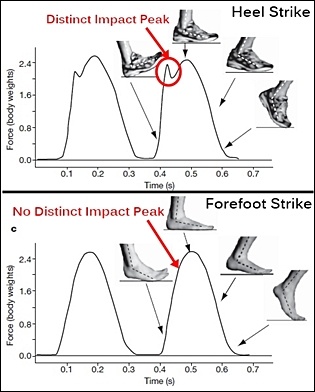Heel strikers and forefoot strikers produce a ground reaction force at touchdown, however the nature of the ground reaction force in heel striking makes heel strikers more prone to injury.

Why Heel Striking Hurts
The initial phase of the ground reaction force in a heel strike shows a peak impact transient (shown right) which is absent in a forefoot strike, and may have implications for injuries such as tibial stress fracture, plantar fasciitis, and patellofemoral pain syndrome.
A 2010 study included in the Annual Meeting of the American Society of Biomechanics, investigated the probability of injury in 240 female heel strike runners and found:
- 139 sustained a new injury of which 70 sought medical treatment
- more than half of the heel strike runners were injured
- for injury distribution, iliotibilal band syndrome, anterior knee pain, tibial stress syndrome, and plantar fasciitis were among the top injuries in the study
As expected, the peak impact transient was greater in the injured heel strike runners than the uninjured heel strike runners.
Though it is acknowledged that running-related injuries are multi-factorial, the researchers concluded that the peak impact transient at heel strike is a global indicator for injury development.
Is Forefoot Striking the ‘Cure-All’ for Running Injuries?
To overcome injury, adopting a forefoot strike makes it possible to increase training volume safely because rapid impact peaks are not produced.
Always bear in mind our ancestors ran long distances barefoot and therefore ran with a foot strike mechanism that’s less forceful than a heel strike.
Many shod runners have long believed that running barefoot is hazardous. Yet, most data suggests humans adapted for barefoot running with a forefoot strike. Running with a forefoot strike while barefoot is a behavioral adaptation to minimize impact, therefore running barefoot is safe and beneficial.
More to Explore:
- Thick-Heeled Running Shoes Reduce Foot Proprioception,
- Heel Strikers Run with More Impact in Minimalist Shoes
- Forget About Arm Swing
- Run Forefoot Site Map
Run forefoot because you are faster than you think!
References:
Davis, IS., Bowser, B., and Mullineaux, D. Do impacts cause running injuries? A prospective investigation.
Bretta Riches
BSc Neurobiology; MSc Biomechanics candidate, ultra minimalist runner & founder of RunForefoot. I was a heel striker, always injured. I was inspired by the great Tirunesh Dibaba to try forefoot running. Now, I'm injury free. This is why I launched Run Forefoot, to advocate the health & performance benefits of forefoot running and to raise awareness on the dangers of heel striking, because the world needs to know.
Latest posts by Bretta Riches (see all)
- Can You Run In Barefoot Shoes? Yes, But DON’T Heel Strike! - 21/07/2024
- Why Cushioned Running Shoes Are Really Bad for Your Feet - 19/07/2024
- Do Cushioned Running Shoes Cause Injuries? - 17/07/2024

Leave a Reply